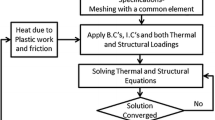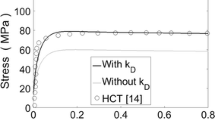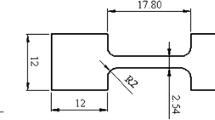Abstract
A comprehensive mathematical model of the hot tandem rolling process for aluminum alloys has been developed. Reflecting the complex thermomechanical and microstructural changes effected in the alloys during rolling, the model incorporated heat flow, plastic deformation, kinetics of static recrystallization, final recrystallized grain size, and texture evolution. The results of this microstructural engineering study, combining computer modeling, laboratory tests, and industrial measurements, are presented in three parts. In this Part I, laboratory measurements of static recrystallization kinetics and final recrystallized grain size are described for AA5182 and AA5052 aluminum alloys and expressed quantitatively by semiempirical equations. In Part II, laboratory measurements of the texture evolution during static recrystallization are described for each of the alloys and expressed mathematically using a modified form of the Avrami equation. Finally, Part III of this article describes the development of an overall mathematical model for an industrial aluminum hot tandem rolling process which incorporates the microstructure and texture equations developed and the model validation using industrial data. The laboratory measurements for the microstructural evolution were carried out using industrially rolled material and a state-of-the-art plane strain compression tester at Alcan International. Each sample was given a single deformation and heat treated in a salt bath at 400 °C for various lengths of time to effect different levels of recrystallization in the samples. The range of hot-working conditions used for the laboratory study was chosen to represent conditions typically seen in industrial aluminum hot tandem rolling processes, i.e., deformation temperatures of 350 °C to 500 °C, strain rates of 0.5 to 100 seconds and total strains of 0.5 to 2.0. The semiempirical equations developed indicated that both the recrystallization kinetics and the final recrystallized grain size were dependent on the deformation history of the material i.e., total strain and Zener-Hollomon parameter (Z), where \(Z = \dot \varepsilon exp \left( {\frac{{Q_{def} }}{{RT_{def} }}} \right)\) and time at the recrystallization temperature.
Similar content being viewed by others
References
Perspectives on Alcan and the Industry, Alcan Public Relations Group, Montreal, Quebec, 1994, vol. 7 (23).
F. Ostermann: in Aluminum Materials Technology for Automobile Construction, W.J. Bantz, ed., Mechanical Engineering Publications Ltd., London, 1993.
I. Gutierrez and M. Fuentes: Recrystallization 90, T. Chandra, ed., TMS, Warrendale, PA, 1990, pp. 807–12.
N. Raghuthan, M.A. Zaidi, and T. Sheppard: Mater. Sci. Technol., 1986, vol. 2, pp. 938–45.
C.M. Sellars, A.M. Irisarri, and E.S. Puchi: in Microstructural Control in Aluminum Alloys: Deformation, Recovery, and Recrystallization, E. Henry Chia and H.J. McQueen, eds., 1985, Feb., pp. 179–96.
H.E. Vatne, T. Furu, R. Ørsund, and E. Nes: Acta Mater., 1996, vol. 44 (11), pp. 4463–73.
E.S. Puchi, J. Beynon, and C.M. Sellars: THERMEC 88, Int. Conf on Physical Metallurgy of Thermomechanical Processing of Steels and Other Metals, Tokyo, June 6–10, 1988, I. Tamura, ed., Iron and Steel Institute of Japan, Tokyo, pp. 572–79.
M. Avrami: J. Chem. Phys., 1939, vol. 7, pp. 1103–12.
M. Avrami: J. Chem. Phys., 1940, vol. 8, pp. 212–24.
M. Avrami: J. Chem. Phys., 1941, vol. 9, pp. 177–83.
M.B. Kuban, R. Jayaraman, E.B. Hawbolt, and J.K. Brimacombe: Metall. Trans. A, 1986, vol. 17A, pp. 1493–1503.
N. Ryum and J.D. Embury: Scand. J. Metall., 1982, vol. 11, pp. 51–54.
T. Furu, K. Marthinsen, and E. Nes: Mater. Sci. Forum, 1993, vols. 113–115, pp. 41–54.
Saul Martinez Rehlaender: Master’s Thesis, University of British Columbia, Vancouver 1994.
S. Srinivasan, J.C. Rossi, and R.O. Sattergood: Scripta Metall., 1991, vol. 25, pp. 931–934.
E.C.W. Perryman: Trans. Am. Inst. Min. Met. Eng., 1955, vol. 203, pp. 369–78.
M.A. Wells I.V. Samarasekera, E.B. Hawbolt, J.K. Brimacombe, and R. Bolingbroke: Light Metals Processing and Applications, CIM Conf. of Metallurgists Proc., CIM, Montreal, 1993, pp. 483–93.
Author information
Authors and Affiliations
Rights and permissions
About this article
Cite this article
Wells, M.A., Samarasekera, I.V., Brimacombe, J.K. et al. Modeling the microstructural changes during hot tandem rolling of AA5XXX aluminum alloys: Part I. Microstructural evolution. Metall Mater Trans B 29, 611–620 (1998). https://doi.org/10.1007/s11663-998-0096-9
Received:
Issue Date:
DOI: https://doi.org/10.1007/s11663-998-0096-9




